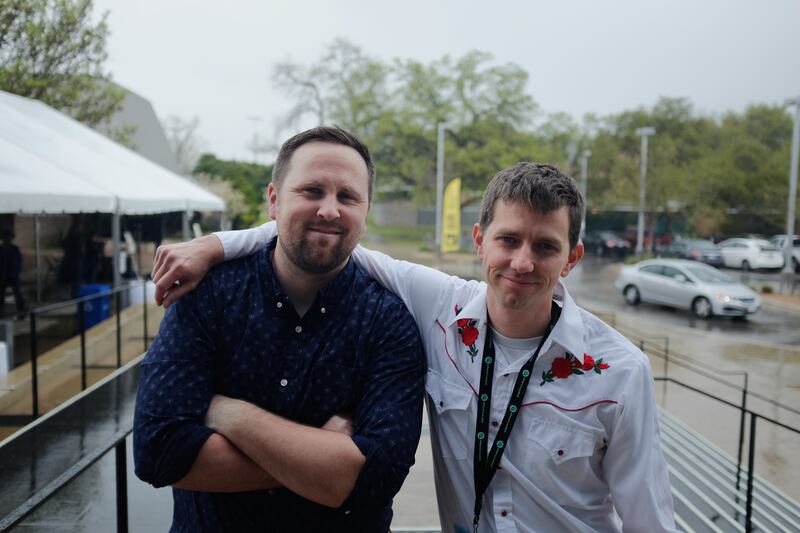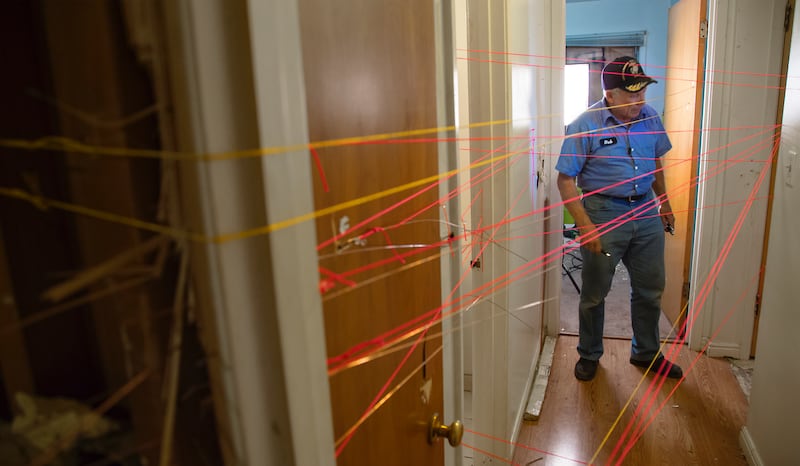SALT LAKE CITY — “If all you have is a hammer, everything looks like a nail.”
Kara Dansky, former senior counsel with the American Civil Liberties Union Center for Justice, turns that phrase in the 2015 documentary “Peace Officer.”
Made in Utah, “Peace Officer” explores police militarization through the lens of a few specific Utah cases. The documentary garnered significant acclaim when it was first released — it won both the Grand Jury Award and Audience Award at the 2015 SXSW Film Festival — but given the recent killing of George Floyd, the ensuing worldwide protests, and increasingly militarized tactics by America’s police forces, “Peace Officer” feels especially timely right now.
We spoke with the film’s creators, Utah residents Brad Barber and Scott Christopherson, as well as its central subject, Farmington resident William “Dub” Lawrence, about America’s ongoing struggle to root out police violence, and how recent events have renewed interest in their documentary.
Comply or die
Lawrence and his family met tragedy in 2008 when Lawrence’s son-in-law, Brian Wood, was shot and killed by Davis County police after a 12-hour standoff in Farmington. While the police initially claimed Wood died by suicide, Wood never shot himself. The lethal bullet came from a police officer’s gun. In “Peace Officer,” local news segments from multiple TV stations are shown, which detail the changing narrative local police officers put forth regarding Wood’s death.
That this local SWAT team killed a member of Lawrence’s own family is unique: Lawrence is a former police officer and helped form that same SWAT team— Utah’s very first — when he was Davis County’s sheriff in the 1970s.
Lawrence said that when he founded Davis County’s SWAT team, its goal was to diffuse, neutralize and ultimately eliminate violence, not escalate it.
“If anybody had gotten hurt, either a police officer or a civilian, it would have been a failed operation,” Lawrence told the Deseret News during a recent phone interview. “The idea of neutralizing and settling a situation peacefully without anybody getting hurt is kind of being supplanted with an idea of comply or die: You either comply, or you get shot.”
“Peace Officer” follows Lawrence’s painstaking efforts to uncover what really happened to his son-in-law, whose police standoff began with a mental breakdown of some kind. The documentary also shows Lawrence taking on other local investigations, such as a 2012 gunfight between former Ogden resident Matthew Stewart and members of the Weber-Morgan Narcotics Strike Force, who had entered Stewart’s home to investigate a marijuana-growing operation.
While the footage in “Peace Officer” can be shocking, it is not uncommon. The documentary shows how the rise of SWAT teams coincided with America’s “war on drugs” in the 1980s. By 2005, SWAT teams were conducting 50,000 raids a year — a 15,000% increase since the late 1970s.
“You’re repeatedly having SWAT teams use violent means for nonviolent crimes. … Search warrants like these ... are causing police to lose their lives as well.” — Scott Christopherson, co-director of “Peace Officer”
And these modern SWAT teams have a lot of gear. Under what’s called the 1033 Program, law enforcement agencies can receive free combat gear from the military on the condition they use the gear within a year. The 1033 program has been a major factor in America’s police militarization. According to a recent piece in Fast Company magazine, more than 8,000 police departments across the country have utilized the 1033 Program.
Brad Barber, co-director of “Peace Officer,” noted a 2014 ACLU study that revealed nearly 80% of SWAT deployments are to execute search warrants, while only 7% are for active shooter or barricaded situations.
In Utah during 2014, these numbers were even more polarized: 83% of Utah’s 559 reported SWAT deployments that year were to serve search warrants for drug crimes, while just 3% were comprised of the categories “active shooter,” “barricaded suspect,” “hostage” and “violent felony warrant.” Only 0.5% of all these reported incidents turned up any civilian firearms. “No-knock” warrants, in which officers aren’t required to announce themselves before entry, comprised 38% of Utah’s 559 reported SWAT deployments that year.
“And as you see in our film, if that happens to you and you don’t know who’s breaking down your door with guns drawn, it can lead to some really scary outcomes for everybody — the citizens and the police,” Barber said.
Added Christopherson, “You’re repeatedly having SWAT teams use violent means for nonviolent crimes. … Search warrants like these — no-knock, or knock-and-announce — are causing police to lose their lives as well. That’s something that stood out to me from making the movie. Thinking about SWAT teams in these terms is costing nonviolent citizens to lose their lives, and police.”

‘You don’t want to think that our country is like this’
Barber and Christopherson said their intentions with “Peace Officer” were never anti-police. It simply began as interest in Lawrence’s unique story. And Lawrence himself, who worked in law enforcement for years, in many ways staunchly supports the rule of law. As Lawrence spent years working to obtain video footage and sundry evidence from his son-in-law’s SWAT standoff — and a few additional years researching the materials once they were obtained — Lawrence learned just how hard it is to bring police officers to justice.
Police officers, he noted, receive far-reaching legal immunity — usually referred to as “qualified immunity” — granted them by years of Supreme Court decisions. Even if a citizen supplies ample evidence that refutes police testimony — as Lawrence himself has done — it’s rarely enough to change any legal outcome.
“A common citizen can no longer petition the government for redress on an equal plane, so equality under the law has been eroded,” Lawrence said.
“Every time I see an officer thrilled and happy that he beat a murder rap on a technicality, that hurts me to the core, because that just means that a government agent gets special privileges and immunities that nobody in America is supposed to have,” he added. “Everybody is supposed to be equal under the law in our country. And that isn’t the case today. And that needs to change.”
“Peace Officer” was released a year after the 2014 demonstrations in Ferguson, Missouri. Barber and Christopherson spent months touring the country with “Peace Officer,” showing it to large audiences and hosting Q&A’s before it aired on PBS. (It’s also currently available to stream on Amazon Prime and Kanopy.) At the time, Barber and Christopherson said they believed it was a sea-change moment in how America handled police militarization. But as protests have swept the country in recent months, and numerous militarized police forces responded to protesters with escalation, violence and arguably unconstitutional tactics, Barber and Christopherson said they wondered how much things had really changed in the six years since Ferguson. They feel encouraged by the continued discussion but worried about the relative lack of change in police tactics.
“You don’t want to think that our country is like this,” Barber said. “You don’t want to think that we live in a country where its own citizens are attacked with tear gas and rubber bullets and worse, just for being in the street at the wrong time, or getting in the way of President Trump wanting to do a photo op with the Bible. It’s really terrifying. It’s not the type of country that I think most of us want to see or recognize. But the experience of making the film certainly made those images familiar.”
Christopherson said he hoped recent events are changing the collective discussion around how police forces are funded and how funds could be diverted to other social programs better equipped to handle issues like housing or mental health.
Mental health, after all, was at the core of Brian Wood’s 12-hour standoff with police forces in Farmington in 2008. Wood became suicidal after getting into a fight with his wife, but no mental health professionals were deployed at the standoff, and 111 total rounds of ammunition were fired at Wood.
“No matter where you fall politically or how you see the role of police, I think something on every side that people could agree on is that police right now are being asked to do too much,” Barber added.
Barber and Christopherson said they think “Peace Officer” works best as a companion piece to other documentaries about law enforcement and police militarization, such as “13th,” “Crime + Punishment” and “The Blood is at the Doorstep.” They hope their documentary, and ones like it, can open up conversations with people who are in positions of power and change.
According to Lawrence, however, that change must run deep or it will not be enough. He compared America’s current situation to a blown fuse: Even if you replace the fuse, the root cause isn’t necessarily the fuse itself — the fuse blew because something shorted it.
“I don’t think they (Congress) understand … how far back we have to go to correct the actual problem,” Lawrence said. “It’s not just police reform or criminal justice reform. Until they get rid of the laws and the Supreme Court rulings that set in motion these consequences, they’re not going to be successful in changing. … To correct it, we’ve got to do something bigger. They need a restoration, not a reform.”


